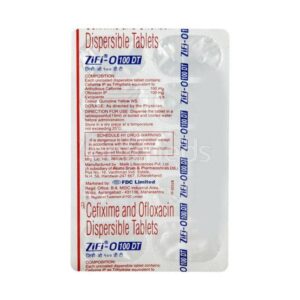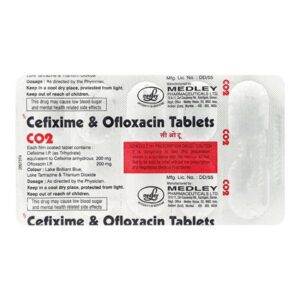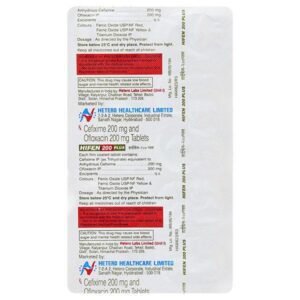OFLOXACIN + CEFIXIME
Ofloxacin: Ofloxacin is a fluoroquinolone antibiotic used to treat various bacterial infections. It works by inhibiting the enzymes responsible for DNA replication and repair in bacteria, effectively killing or inhibiting the growth of the bacteria causing the infection.
Ofloxacin can be used to treat respiratory tract infections, urinary tract infections, skin infections, and sexually transmitted infections, among others. It is particularly effective against Gram-negative bacteria, including Escherichia coli, Klebsiella pneumoniae, and Pseudomonas aeruginosa.
The dose of ofloxacin varies depending on the specific infection being treated. It is typically taken orally, usually once or twice daily. The exact dosage and duration of treatment should be determined by a healthcare professional based on the individual’s condition.
Like any medication, ofloxacin has potential side effects. Common side effects include nausea, vomiting, diarrhea, stomach pain, dizziness, and headache. Rare but serious side effects can occur, such as tendon rupture, allergic reactions, liver damage, and photosensitivity (increased sensitivity to sunlight). It is important to consult a healthcare professional if any severe or persistent side effects occur.
Ofloxacin interacts with certain medications, so it is crucial to inform the healthcare provider of any other drugs being taken. It should not be taken with antacids, iron or zinc supplements, or any products containing magnesium, aluminum, or calcium, as they can decrease its absorption and effectiveness.
As with any antibiotic, it is important to complete the full course of ofloxacin treatment, even if symptoms improve, to prevent antibiotic resistance and ensure the eradication of the infection.
Cefixime: Cefixime is an antibiotic medication used to treat bacterial infections. It belongs to the class of drugs known as cephalosporins and is specifically a third-generation cephalosporin.
The main mechanism of action of Cefixime is to inhibit the growth of bacteria by interfering with their cell wall synthesis. It does this by binding to specific proteins in the bacteria called penicillin-binding proteins, which ultimately leads to the disruption of the bacterial cell wall formation and subsequent cell death.
Cefixime is commonly prescribed to treat various infections such as respiratory tract infections, urinary tract infections, ear infections, and certain sexually transmitted infections. It is effective against a wide range of bacteria, including Streptococcus pneumoniae, Haemophilus influenzae, and Escherichia coli.
The typical adult dose of Cefixime for most infections is 400 mg per day, which can be given either as a single daily dose or divided into two doses of 200 mg. The duration of treatment may vary depending on the type and severity of the infection, but it is usually recommended to continue treatment for at least 7 to 14 days.
Like any medication, Cefixime can cause certain side effects. Common side effects may include diarrhea, nausea, stomach pain, headache, and vaginal itching or discharge. These side effects are usually mild and temporary. However, it is important to seek medical attention if any severe or persistent side effects occur, such as severe watery or bloody diarrhea, severe stomach pain, or signs of an allergic reaction (e.g., rash, itching, swelling, difficulty breathing).
It is crucial to take Cefixime exactly as prescribed by the healthcare provider and to complete the full course of treatment, even if symptoms improve before the completion. Skipping doses or stopping treatment prematurely can contribute to the development of antibiotic-resistant bacteria.



